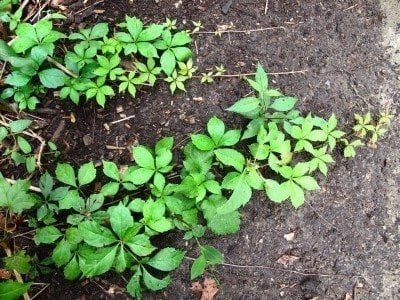The Virginia Creeper is a tenacious plant and spreads very fast. It can kill plants it grows on as it blocks them from receiving sufficient sunlight and also contains raphides that can cause skin irritations.
Furthermore, if your walls have some cracks, the vine can easily get in and cause damage. Luckily, there are ways to get rid of Virginia creeper; both naturally and using artificial solutions.
How do you kill Virginia creeper naturally?

- Cut the creeper’s main trunk using pruners. Ensure the point you cut is as close to the ground as possible.
- Then pull away from the Virginia creeper cut from the structure, shrubs and/or trees to remove it. Be keen not to damage the structure or tree during the process.
- Be on the lookout for any new growth signs where the creeper was cut. If you see any growth, immediately remove it to stop it from growing back.
Remember to put on protective gear when cutting. Put on safety glasses and long-sleeved gloves, as well as a long-sleeved shirt.
The other option to eliminate the Virginia creeper vine growing on your property is by using a good herbicide. There is a number of herbicides that claim to destroy the Virginia creeper.
Check this too: How to Neutralize Muriatic Acid
However, not all may be as effective as advertised. So which herbicide kills Virginia creeper and is effective to use?
The most effective product to use on the creeper is diluted glyphosate. This glyphosate may come in different brands such as Roundup.
The product preference may, therefore, depend on other factors such as cost and usability. Nevertheless, it is important to note that the glyphosphate is a non-selective vegetation killer.
You need to be extra careful not to get it on other vegetation. Here is how to use it:
- First, read and follow the dilution instructions written on the product label
- Hold the Virginia creeper away from your body
- Use a foam paintbrush to paint the product on the Virginia creeper
Is Virginia Creeper poisonous?
The Virginia creeper is toxic. Its berries can be harmful to humans if ingested as they contain amounts of oxalic acid. However, birds are not harmed by eating these berries.
The sap contacts oxalate crystals that are needle-like and can cause a rash or skin irritation to some people.
That is why it is important to wear gloves, especially if you are sensitive when coming into contact with the plant.
Check this too: Best Grow Lights For Succulents
Poison ivy is often mistaken for Virginia creeper as they often grow together. They are different plants that can simply be differentiated from their leaves. While Poison ivy has just three leaves, the creeper has five. Also, Virginia creeper leaves turn bright red during fall.
While the Virginia creeper may be a good plant for providing fall color, the potential negative effects of allowing it to grow around your property may outweigh the positive. In such a case, the methods discussed above should effectively help you get rid of the plant.
